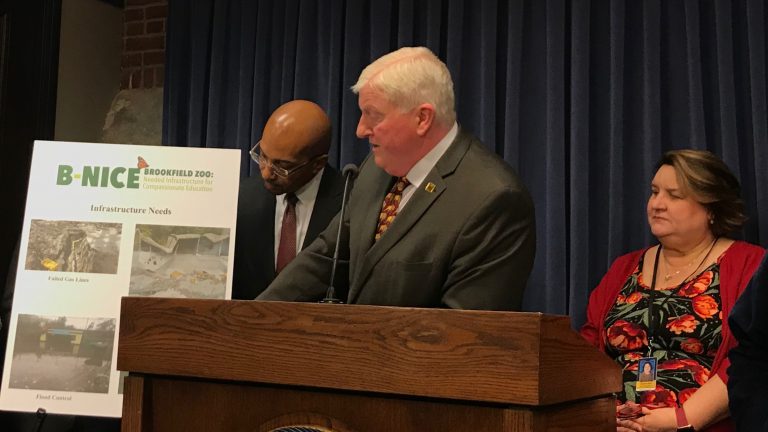Crumbling sidewalks, gas line failures and cracked concrete — the problems at Brookfield Zoo are a metaphor for what’s wrong with public infrastructure throughout Illinois.
As lawmakers begin negotiating a statewide spending plan to fix it, the zoo is among a growing list of those coming to Springfield with their paws out.
The Chicago Zoological Society, the nonprofit that runs the zoo, is asking state lawmakers for help rehabbing and improving its facilities from a promised capital plan.
“The more we receive from the state to help repair crumbling infrastructure, the more we’re able to focus on sustaining and expanding our STEM education, conservation education, science, nature, leadership and accessibility programs that directly benefit communities from our region,” Stuart Strahl, president of the Chicago Zoological Society, said at a news conference Wednesday.
They put their infrastructure needs at around $260 million, but aren’t asking for the full amount from the state. Still, without some funding, Strahl said they may have to raise admission prices or cut education programs.
For Illinois, lawmakers have to figure out how to pay for a capital plan, the first in more than decade. They are tight lipped about the possibilities, but past plans have increased vehicle registration fees and sought new revenue from video gambling.
Beyond funding, they need to decide which projects would get the money.
“Transparent and Objective”
There is the state’s own long list of needed infrastructure projects – the interstates that need to be repaved and buildings that need to be repaired.
State colleges and universities have asked for around $2 billion in capital funds for the next fiscal year (PDF). City and county governments and transit authorities will have requests as well.
Then there are community and economic development projects, like the Brookfield Zoo improvements or Democratic state Sen. Andy Manar’s proposal for $50 million for a new Southern Illinois University building in downtown Springfield.
Beverly Bunch, a University of Illinois Springfield public administration professor, said there are two schools of thought for divvying up capital spending: give each lawmaker a pot of money and let them select the most needed projects in their district, with the assumption that local officials know their district best; or create a statewide system for assessing and ranking projects to decide which will get money.
“In reality, it’s something in between the two,” she said.
And that seems to be the case for this year’s capital plan.
The governor’s transition team for infrastructure called for a “transparent and objective project prioritization” in its report released last week.
“I heard loud and clear from planning agencies throughout the state that we should do this on a needs basis, some kind of an assessment to put in place to make sure that the needs of the declining infrastructure are met,” said state Rep. Jay Hoffman, a Belleville Democrat and a co-chair of the committee.
“And new projects are assessed on a basis of whether or not they’re really needed for growth in areas or for other reasons, like safety.”
State agencies, like the departments of Transportation and Natural Resources and the Environmental Protection Agency, will have a role in assessing needs, Hoffman said. But legislators will have to make their cases, too.
“What you’re going to have to do is you’re going to have show that some of the needs of people in their district, whether it’s a road or a bridge or school, are being addressed,” Hoffman said.
The transition team’s report also said the plan should prioritize projects that drive economic growth as well as ones that address health and safety risks, such as water contamination and deficient bridges.
Bunch said those types of arguments can be subjective.
On top of that, state leaders have to take into account getting enough votes to approve a big piece of legislation that will likely include some unpopular ways to pay for the projects, such as raising fees or taxes.
“You’d like to think statewide, we’re looking at what are the highest priorities, but [lawmakers] also tend to look at what it’s going to take to get the bill through,” Bunch said.
The last major capital plan, the $31 billion Illinois Jobs Now! Act (PDF), was signed by then-Gov. Pat Quinn in 2009. Two-thirds went to transportation related projects. Another several billion went to K-12 and higher education facilities, and environmental and economic development projects.
Several hundred million dollars was earmarked for community development projects, including $17 million for Brookfield Zoo.
Brookfield’s Case
Richard Gamble, the chief operating officer for the Chicago Zoological Society, said the money from 2009 resulted in $51 million in economic activity.
“Additional funding will help build new exhibits that inspire conservation, help expand free admission programs for those from under-resourced communities and allow for greater outreach and communities for years to come,” he said.
Brookfield Zoo does have friends at the statehouse. State Rep. Kathleen Willis, an Addison Democrat, said she appreciates the educational programs that serve schools in her district.
“Brookfield Zoo is something that everybody throughout the entire state benefits [from],” she said. “So it’s not just strictly for the district that the zoo is housed in.”
Lawmakers will likely hear similar arguments for projects as the capital plan negotiations continue. They’ll get input from the public as well.
The Senate Transportation and Appropriations committees announced last week they will hold joint public hearings on a capital plan around the state in the coming weeks. Dates and venues have not yet been announced.


